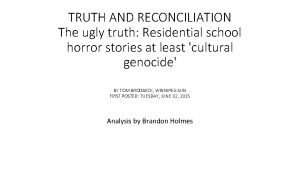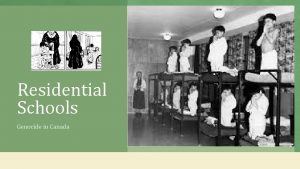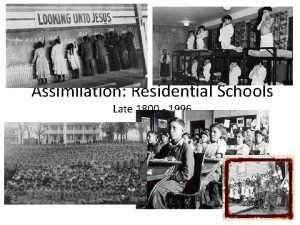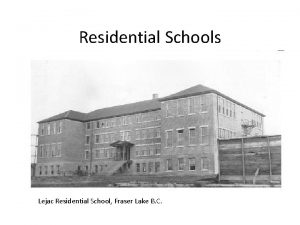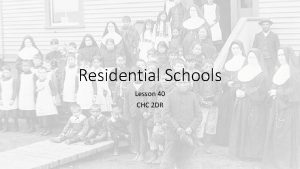Mission Day and Residential Schools Mission Schools As










- Slides: 10

Mission, Day and Residential Schools

Mission Schools �As European traders reached Canada, missionaries came as well �Missionaries: Representatives from the church sent to teach their religion to different cultures. �Government and churches saw education as a tool to build relationships with First Nations people �They saw First Nations culture as “uncivilized” and wanted to bring their European knowledge to First Nations people

�Goal of assimilation: government thought that First Nations people would happily leave their traditional beliefs and culture for a European way of life. �They believed assimilation could be achieved best by educating the children. � The government saw assimilation as a way of helping First Nations people adapt to living in “modern” European society �The missionaries saw assimilation as a way of saving the First Nations people from their “heathen” lives.

�By the 1840 s, Catholics, Anglicans and Methodists ran mission schools in Eastern Canada, spreading across the country as Europeans settled. �Ryerson, a Methodist Minister, recommended the government build, fund and inspect First Nations schools and the churches staff and operate them. �The government did not attempt to control Inuit education until the mid-1900 s, since the Europeans had not settled in the north until that point. �Metis people were also not considered First Nations, so they were not included in this system

Day Schools � 1867: Canada became a country and “Indians and Indian land” was now the responsibility of the federal government �Day schools were built on reservations where children would attend only during the day (like modern schools) �It became clear that the children were not being educated successfully and were not being assimilated.

�Some children did not attend school �Families continued moving, so children would not stay at the same school �First Nations protested the schools did not meet their needs �Government was spending money with no results �Missionaries could not control the children and found it hard to convert them to Christianity

Residential Schools �In 1879, Nicholas Flood Davin studied US boarding schools and released a report for Canadian schools: �Separate children from their families and communities �Take children as far away as possible from their community �Children should be trained to lead a Christian lifestyle �“If anything is to be done with the Indian, we must catch them very young” - Davin

�The government agreed with Davin’s suggestions, creating Indian Residential Schools �Some First Nations children had a positive experience at residential schools �Majority of staff believed they were doing good and acting with the child’s best interest in mind.

� 1868 – 2 residential schools in Canada � 1894 – 45 residential schools in Canada � 1894 – residential school attendance was compulsory due to changes in the Indian Act � 1930 – 80 residential schools �Indian agents could hold students at schools until they were 18 years old

� 1930 s-1960 s: Inuit children were taken to residential schools �Many were extremely far away from their communities �They would not be able to go home for holidays or summer �Some did not see their families for many years �Metis children were ignored by the government and were not educated.




